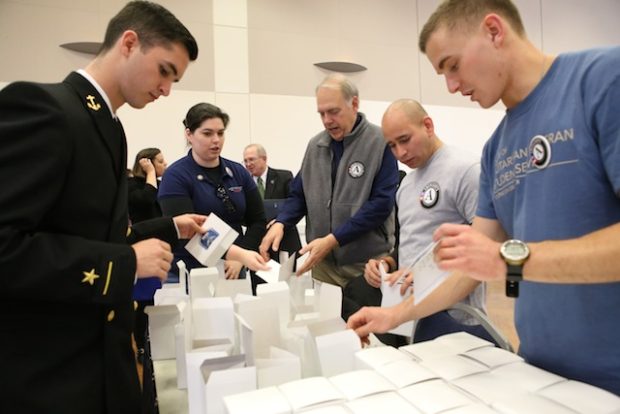
At the Crossroads of the Military-Civilian Divide
John Lira, Veterans and Military Program Officer, Corporation for National & Community Service
This editorial was written as the result of a collaboration between Veterans Coming Home (www.veteranscominghome.org) and Corporation for National and Community Service (www.nationalservice.org).
National service is the fiber that binds, rather than divides, the citizenry of our country.
Whether through service in high-need communities or abroad in the combat zone, all service requires inspiration, commitment, and sacrifice to positively impact peoples’ lives.
For the last two years, I have served as the Veterans and Military Families Program Officer at the Corporation for National and Community Service (CNCS). CNCS is the federal agency responsible for motivating and mobilizing five million + Americans to serve in communities, improve the lives of their fellow citizens, and tackle the country’s most pressing community challenges by serving in AmeriCorps, AmeriCorps VISTA, and Senior Corps programs. Before joining CNCS, I was not familiar with the term “national service” and simply thought it was synonymous with military service. I have since learned and witnessed the profound impact AmeriCorps members and programs are having in communities across the country.
While there is a noted lack of understanding between military and civilians who serve our country, this does not mean that we share nothing in common. Now, at the center of the military-civilian divide, I understand more than ever the different avenues of national service and, more importantly, I understand the common bonds between those who serve and the fulfilling pride of knowing you have made a difference in somebody’s life. The terms of service, compensation, and mission might differ, but the commitment individuals make to do their part to strengthen the country is the same.
I believe the desire to be part of a meaningful cause or mission is embedded in all of us. This innate desire to step up and make a difference is the common denominator found in all Americans who choose to serve. While it seems that only a small percentage of citizens volunteer to serve in the military for four years to keep our country secure, a much larger percentage of citizens pledge to serve a year in their community combating poverty, educational inequality, and providing disaster relief.
My calling came at the age of 17 when I raised my right hand to serve in the Marine Corps. I joined the Marines because I wanted to do something meaningful after graduation; something that would inspire pride and have a lasting impact on me, my family and my country. I felt serving in the Marines would permanently redefine what honor, courage, and commitment meant to me. I wanted to do my part.
Choosing national service means committing to serve a cause greater than yourself. The commitment involves the giving of your time, effort, and resources, not for personal gain, but, for the betterment of American society. I first experienced this feeling in 2003, when I was among the first US combat forces to cross from Kuwait into Iraq in Operation Iraqi Freedom. The magnitude of the moment made me feel like I was part of something that would be forever inscribed in the annals of our nation’s history.
I imagine AmeriCorps members feel the same way when they join an organization to provide services that have a profound impact in the lives of their fellow citizens and their community. Take for example, AmeriCorps VISTA member, Antuan Wilson, who left a high-salaried position at a Fortune 500 company to become a volunteer because he felt a yearning to give back, to make a difference, to impact the his community and the people around him. Or, AmeriCorps VISTA member, Elizabeth Oliver, who assisted 97 homeless veterans in gaining housing and was central to Salt Lake City, Utah becoming one of the first cities to end chronic veteran homelessness.
The actual impact of a service also takes on many forms. For example, it is difficult quantify the day-to-day impact that military service has on our lives; every day the U.S., and her allies, do not get attacked is a successful outcome. For community service, the outcomes are more tangible and the impacts are directly felt by the individuals being served. I am inspired by stories of AmeriCorps members making an impact in their community as much as I am by stories of heroism on the battlefield.
All service requires sacrifice. In 2005, I deployed to Iraq for a second time during the height of the insurgency and experienced heavy burden of military service when, over the course of seven months, 48 Marines and Sailors made the ultimate sacrifice. The public is generally aware of the sacrifices involved with military service, more so than sacrifices of serving in the community. However, AmeriCorps members serve in some of the most impoverished communities with the most at-risk populations and receive relatively modest, if any, compensation for their efforts.
As a young Marine, I never envisioned working for a civilian organization that impacts the lives of millions of Americans across the country. I am inspired to continue serving alongside other veterans like Joseph Clay, Loretta Coleman, and Tyler Wright who are making impacts in their communities. I understand the value that veterans bring to community programs and the tangible and intangible benefits that a year of service in AmeriCorps provides veterans. AmeriCorps helps bridge the military-civilian divide by offering veterans opportunities hone their existing skills while developing new skills and becoming leaders in their community. I encourage veterans seeking to continue serving the country as community leaders to visit AmeriCorps’s veteran website (www.americorps.gov/veterans), as well as check out Veterans Coming Home’s coverage of stories that seek to bridge the military-civilian divide (www.facebook.com/vetscominghome).




